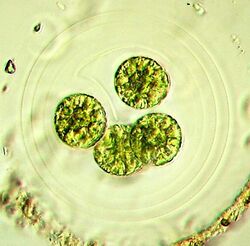Biology:Asterococcus
| Asterococcus | |
|---|---|

| |
| Asterococcus superbus | |
| Scientific classification | |
| (unranked): | Viridiplantae |
| Division: | Chlorophyta |
| Class: | Chlorophyceae |
| Order: | Chlamydomonadales |
| Family: | Palmellopsidaceae |
| Genus: | Asterococcus Scherffel[1] |
| Species | |
|
See text | |
Asterococcus is a genus of green algae in the order Chlamydomonadales.[1] It is planktonic in freshwater ponds and lakes, or benthic within mires and swamps. It is a common and widespread genus, but is rarely abundant.[2]
Taxonomy
The botanist Leon Cienkowski was the first to observed organisms now assigned to Asterococcus, when he described the taxon Pleurococcus superbus in 1865. Later in 1908, Aladár Scherffel transferred that species into a new genus, and named it Asterococcus.[3]
Asterococcus is monophyletic. Currently, taxonomic databases such as AlgaeBase place this genus in the family Palmellopsidaceae. However, molecular phylogenetics have demonstrated that it is most closely related to some species of Carteria, such as Carteria radiosa.[4]
Description
Asterococcus consists of colonies in powers of two (two, four, eight, 16, rarely up to 64), or occasionally single cells, embedded within a conspicuous, often layered mucilaginous envelope. The cells are usually spherical to ellipsoidal and are either dispersed in the envelope or attached to the end of a branched (dendroid), mucilaginous stalk. Cells are 10–40 μm in diameter with smooth cell walls, a single nucleus and usually with two contractile vacuoles. Cells contain a single chloroplast in the center of the cell with a central pyrenoid, with numerous radiating lobes flattened against the cell wall.[2][1]
Reproduction in Asterococcus occurs asexually by the formation of aplanospores or zoospores, of which two to eight are produced per cell. Once formed, they are released through the dissolution of the parent cell wall. Sexual reproduction has never been observed in this genus.[1]
Species
There are currently five recognized species within the genus:[4]
- Asterococcus korschikoffii Ettl
- Asterococcus limneticus G.M.Smith
- Asterococcus papillatus Nakazawa
- Asterococcus spinosus Prescott
- Asterococcus superbus (Cienkowski) Scherffel
Species identification in Asterococcus depends on morphological criteria such as the form of the colony (dendroid or not), characteristics of the cell wall, and whether the colonial envelope is lamellated or not.[4]
References
- ↑ 1.0 1.1 1.2 1.3 Guiry, M.D.; Guiry, G.M. (2008). "Asterococcus". AlgaeBase. World-wide electronic publication, National University of Ireland, Galway. http://www.algaebase.org/browse/taxonomy/?id=43405.
- ↑ 2.0 2.1 Shubert, Elliot; Gärtner, Georg (2014). "Chapter 7. Nonmotile Coccoid and Colonial Green Algae". Freshwater Algae of North America: Ecology and Classification (2 ed.). Elsevier Inc.. ISBN 978-0-12-385876-4.
- ↑ Scherffel, A. (1908). "Asterococcus n. g. superbus (Cienk.) Scherffel und dessen angebliche Bezeichnungen zu Eremosphaera". Berichte der Deutschen Botanischen Gesellschaft 26A: 762–771. https://www.biodiversitylibrary.org/item/139101#page/816/mode/1up.
- ↑ 4.0 4.1 4.2 Nakazawa, Atsushi; Yamada, Toshihiro; Nozaki, Hisayoshi (2004). "Taxonomic study of Asterococcus (Chlorophyceae) based on comparative morphology and rbcL gene sequences". Phycologia 43 (6): 711–721. doi:10.2216/i0031-8884-43-6-711.1. Bibcode: 2004Phyco..43..711N.
External links
Scientific references
- PubMed references for Asterococcus
- PubMed Central references for Asterococcus
- Google Scholar references for Asterococcus
Scientific databases
- NCBI taxonomy page for Asterococcus
- Search Tree of Life taxonomy pages for Asterococcus
- Search Species2000 page for Asterococcus
- AlgaeBase
- AlgaTerra database
- Index Nominum Genericorum
Wikidata ☰ Q4810740 entry
 |

